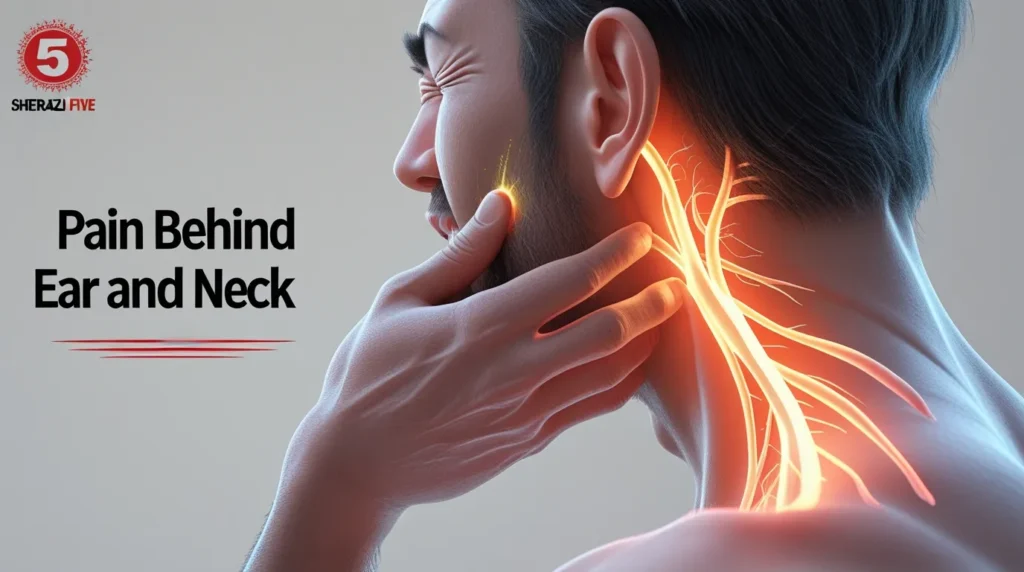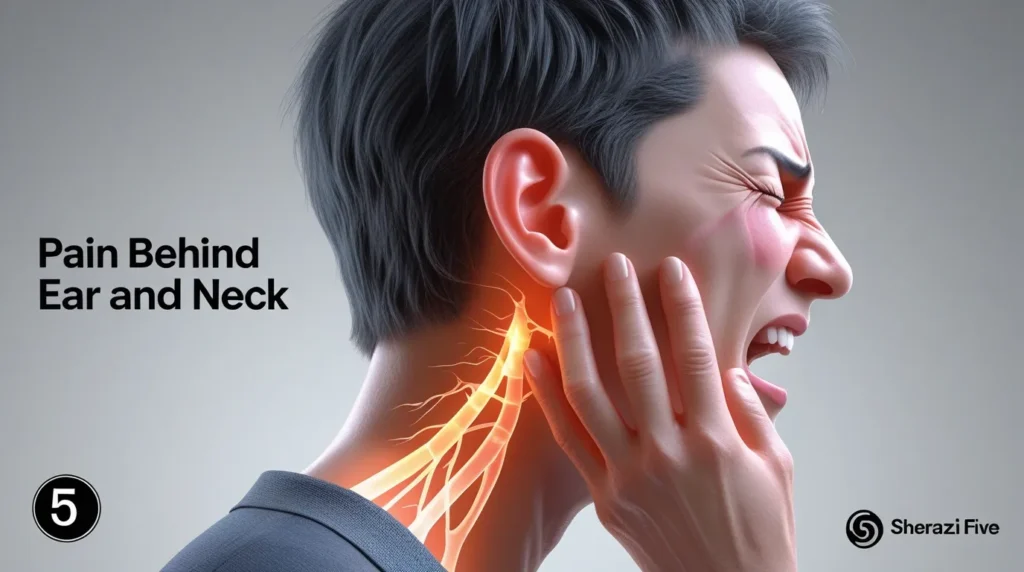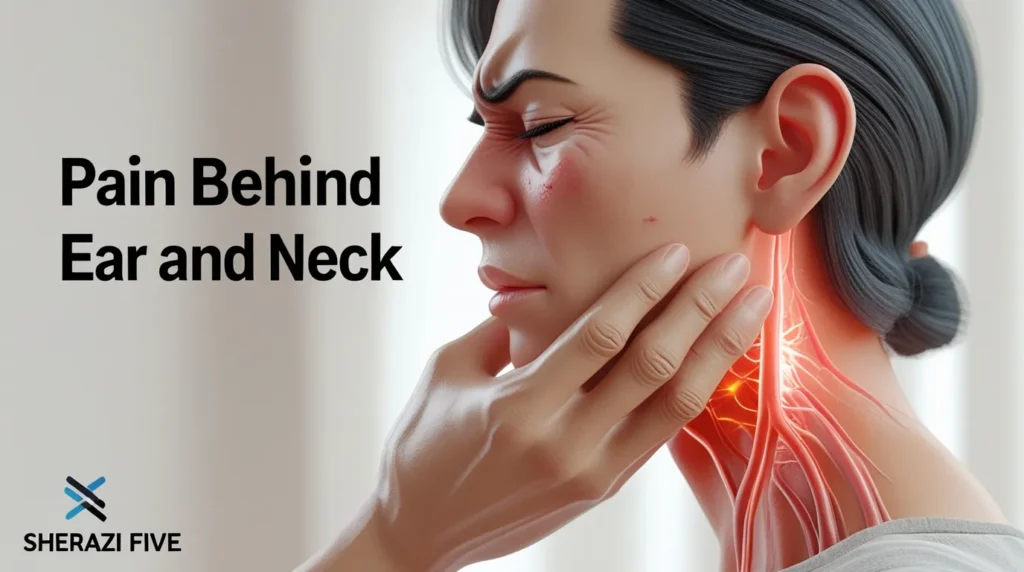Have you ever experienced that uncomfortable pain behind ear and neck that seems to come out of nowhere? It can range from a dull ache to a sharp throbbing that makes it hard to focus on your daily routine.
Many people dismiss it as minor tension, but in reality, this pain may be linked to a wide variety of causes. From muscle stiffness to nerve compression or even an underlying ear infection, the discomfort should never be ignored. In this guide, we’ll explore the causes, symptoms, treatment options, and effective prevention strategies that can help you understand and manage this problem better.
Common Causes of Pain Behind Ear and Neck

One of the most frequent causes of pain behind ear and neck is tension in the muscles. Poor posture, especially from sitting long hours at a desk, strains the cervical spine. Over time, this can trigger chronic neck pain and spread discomfort toward the ear.
Another major reason is infection. An inner ear infection or mastoid bone pain can radiate toward the neck. At times, conditions like TMJ disorder or even migraines can also lead to ear and neck discomfort.
Symptoms That Often Come With This Pain
The pain doesn’t always show up alone. Many people experience additional signs such as headaches, a dull neck ache, or stiffness that limits mobility. Some also complain of dizziness or an uncomfortable ear ringing (tinnitus).
In more severe cases, swelling around the ear or pressure in the jaw joint may occur. These symptoms are crucial clues that help doctors identify whether it’s just stress-related pain or a deeper medical issue.
When Pain Behind Ear and Neck Becomes Serious

Mild pain usually fades with rest and simple care, but there are times when it should not be ignored. Persistent throbbing pain lasting several days, fever, or discharge from the ear are strong warning signals.
If you notice vision changes, numbness, or severe sharp pain behind ear, it’s important to seek medical attention immediately. These may point to serious infections or cervical spine problems that require urgent treatment.
Medical Conditions Linked to Pain Behind Ear and Neck
There are several health issues directly connected to this discomfort. TMJ disorder often causes pain in the jaw, spreading behind the ear and into the neck. Migraines, on the other hand, may produce migraine-related ear pain that feels like pressure near the mastoid bone.
Conditions like mastoiditis—an infection in the mastoid bone—can trigger swelling, fever, and intense pain. Cervical spondylosis, a wear-and-tear condition of the spine, also leads to nerve compression, worsening neck stiffness and radiating pain around the ear.
How Doctors Diagnose the Problem

Doctors start with a physical examination, checking for tenderness and swelling. If they suspect infection, they may order blood tests. For structural issues, X-rays or MRI scans of the cervical spine are often used.
In cases linked to ear trouble, doctors may examine the eardrum with an otoscope. These tests help confirm whether the cause is related to ear infection, bone damage, or simple muscle strain.
Effective Home Remedies for Quick Relief
Mild cases of pain behind ear and neck often respond well to simple remedies. Applying a warm compress can ease muscle tension, while gentle stretching improves flexibility. Adequate rest, hydration, and correction of posture play an important role in healing.
Over-the-counter pain relievers also bring comfort, but natural remedies like herbal teas or essential oils can be equally soothing. If pain persists, however, these methods should not replace professional medical care.
Medical Treatments for Severe Cases

When infections or chronic conditions are diagnosed, doctors may prescribe antibiotics, anti-inflammatory medicines, or even physical therapy. For TMJ disorder, a dental specialist may recommend bite guards to reduce pressure on the jaw joint.
In rare but severe cases, surgery may be needed to correct cervical spine problems or drain infected areas in the mastoid bone. Early treatment is essential to avoid permanent damage.
Prevention Tips for Pain Behind Ear and Neck
Preventing this type of pain is easier than managing recurring flare-ups. Adjust your workstation ergonomically to reduce neck strain. Practice relaxation exercises to release stress that often causes muscle stiffness and headaches.
Regular stretching and yoga can also keep your neck and back flexible. Simple habits like drinking enough water and getting quality sleep make a noticeable difference in long-term health.
Lifestyle Changes That Reduce Pain

Adopting healthier daily routines can reduce the risk of experiencing pain behind ear and neck. Regular workouts, especially those targeting the upper body, build strength and protect against injury.
Maintaining a nutrient-rich diet supports bone and muscle health. Cutting back on caffeine and alcohol also helps reduce migraine frequency, lowering the chances of ear and neck discomfort.
Table: Quick Comparison of Causes and Treatments
| Cause | Common Symptoms | Possible Treatment |
|---|---|---|
| Muscle Tension | Stiff neck, dull ache | Warm compress, stretching, posture fix |
| Ear Infection | Fever, swelling, ear discharge | Antibiotics, medical exam |
| TMJ Disorder | Jaw pain, clicking sound | Bite guards, dental therapy |
| Cervical Spine Problems | Stiffness, nerve compression | Physical therapy, surgery if severe |
| Migraine or Stress Headache | Throbbing pain, dizziness | Rest, hydration, medication |
Final Thoughts on Pain Behind Ear and Neck
Experiencing pain behind ear and neck can be frustrating, but understanding the possible causes helps you take action quickly. While home remedies bring relief in many cases, persistent pain should always be checked by a healthcare professional.
Remember, your body sends signals when something is wrong. Listening to these signals and making proactive lifestyle changes can save you from long-term complications and improve your overall well-being.
FAQs
Why do I have a weird feeling behind my ear?
It may be due to muscle tension, nerve irritation, or an ear infection causing discomfort or pressure.Why do I have a dull ache behind my ear?
A dull ache is often caused by muscle strain, mastoid inflammation, or mild ear infections.What causes mastoiditis in children?
Mastoiditis usually develops from untreated middle ear infections (otitis media) spreading to the mastoid bone.What is the dull ache in the bone behind the ear?
This can indicate mastoid bone inflammation, infection, or pressure from nearby lymph nodes.What is the three finger test for mastoiditis?
It’s a clinical method where doctors press the mastoid bone behind the ear to check for tenderness and swelling.What can be mistaken for mastoiditis?
Swollen lymph nodes, ear infections, TMJ pain, or skin infections can mimic mastoiditis symptoms.Is there a lymph node behind your ear?
Yes, there are small lymph nodes located just behind the ear that can swell with infections.How to test for mastoiditis?
Doctors examine the area for tenderness, swelling, redness, and may use imaging like CT scans for confirmation.What is neuralgia behind the ear?
It’s sharp, shooting pain caused by irritation or compression of nerves in the neck or ear region.Can you feel a tumor behind your ear?
Yes, tumors may present as a firm, painless, or slowly growing lump behind the ear.What is the inflammation behind the ear?
Inflammation can result from infections, lymph node swelling, skin conditions, or mastoiditis.Why do I have a pain in my neck behind my ear?
Pain here may be due to muscle strain, cervical spine issues, ear infections, or swollen lymph nodes.What are the signs that you have a cancerous lymph node?
Signs include a hard, painless, immovable lump that grows over time, sometimes with night sweats or weight loss.How to test for lymphoma?
Doctors perform physical exams, blood tests, imaging, and often a lymph node biopsy to confirm lymphoma.What are the most worrisome lymph nodes?
Persistent, hard, immovable, and rapidly growing lymph nodes, especially in the neck, armpit, or groin, are most concerning.





Pingback: Ear And Jaw Pain Behind Ear Causes, Symptoms, And Treatment